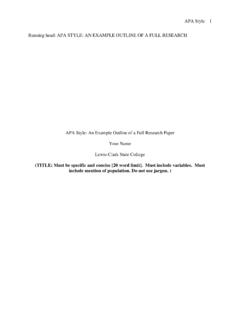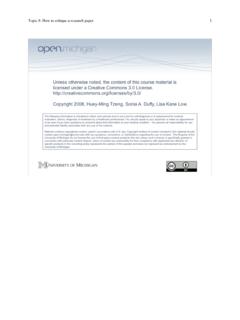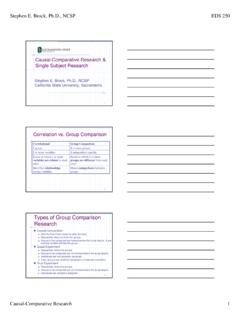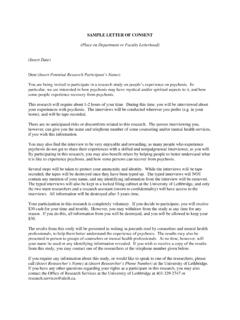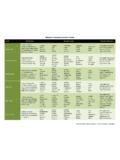Transcription of I. Research Proposal 1. Background
1 Sample CFDR Research ProposalI. Research Proposal 1. Background Diabetes has been described as the the perfect epidemic afflicting an estimated 104million people worldwide (1). By 2010, this figure is expected to double (2). Diabetes isnot only a common chronic disease but it meets all 3 criteria for a public healthdisorder (3). The goal of the clinical management of all forms of diabetes is to controlmetabolic abnormalities in order to prevent acute (hyperglycemia and hypoglycemia) andlong-term complications (retinopathy, nephropathy, neuropathy and cardiovasculardisease) without negatively impacting on quality of life (3). Two landmark studies (4,5)have confirmed that attainment of glycemic control as close to normal as possible isnecessary for prevention of long term complications in both type 1 (4) and type 2 (5)diabetes and this requires an intensive approach to management.
2 Nutrition is of utmostimportance in intensive management (6) and has often been described as the cornerstoneof diabetes care (3). The main focus in the nutritional management of diabetes is toimprove glycemic control by balancing food intake with endogenous and /or exogenousinsulin levels (7). Historically, there have been several attempts to control the glycemicresponse to food, particularly carbohydrate-containing foods, including use of very lowcarbohydrate and starvation diets, artificial sweeteners and pharmacological preparationssuch as fast acting insulin and inhibitors of carbohydrate absorption (8). One way toclassify the glycemic response of various carbohydrate-containing foods is GlycemicIndex (GI).
3 This term was first coined by Jenkins to describe the extent that bloodglucose rises after a test food in comparison to a reference food, usually white bread (9).Although the concept of the GI has made it easy to predict the glycemic response ofpredominantly carbohydrate-containing foods, the clinical utility of this concept has beenseriously questioned, especially as it pertains to mixed meals (10). As well, there hasbeen concern that patients may misapply the GI concept (10). This concern is similar tothe one raised when the Canadian Diabetes Association released the sucrose guidelines in 1992 (11). Dietitians were at first reluctant to teach clients with diabetes how toincorporate the added sugar choices into their meal plan out of concern that they wouldmisapply the information and would lead to a deterioration in metabolic control.
4 A long-term study of free-living adults with type 2 diabetes revealed that this concern wasunfounded as metabolic control did not deteriorate (12). Although currently not endorsed by the American Diabetes Association (13), the GI isbeing advocated by most diabetes and health organizations world wide including theWorld Health Organization, the Diabetes Nutrition Study Group of the EuropeanAssociation for the Study of Diabetes and the Canadian Diabetes Association (7). The useof the GI in clinical practice, and in particular the use of low GI diets, is being advocatedby a joint Food and Agriculture Organization (FAO) and World Health Organization(WHO) Expert Consultation (14).
5 The report of this consultation suggests using the GI asa way to guide food choices and to develop exchange lists. The report also suggests howthe GI can be applied to mixed meals or whole Currently, in the management of diabetes, glycemic control is assessed by fasting,pre-meal and long-term blood glucose levels (3). However, post-prandial glycemiashould also be considered as it may be an independent risk factor in the development ofcomplications related to diabetes (15-17). As post-prandial glycemia is influenced byboth the amount and the source of carbohydrate (7), the Glycemic Index is a veryimportant concept to consider. Furthermore, there is a growing body of scientificevidence, including data from epidemiological (18,19) and clinical studies (20-22)linking low Glycemic Index diets with improved outcomes including decreased risk ofdevelopment of type 2 diabetes (18,19) and improved metabolic control (20-22) andquality of life (20)
6 In individuals with established Objective and HypothesisGiven the growing body of evidence regarding the potential benefits of the GlycemicIndex in the prevention and clinical management of diabetes and in view that the GIconcept is being advocated by the World Health Organization and the Canadian DiabetesAssociation, it is important to determine the current practices and perceptions ofCanadian dietitians with respect to the use of the Glycemic Index in the nutritionalmanagement of individuals with diabetes objective of this study is to determine factors associated with use and non-use of theGlycemic Index concept.
7 The factors to be studied are: perceptions (benefits, barriers,confidence in teaching Glycemic Index); knowledge and sociodemographic andprofessional characteristics (age, gender, province of work, number of years sincegraduation, number of clients with diabetes counseled per week).HypothesisDietitians who use the Glycemic Index will be more likely to have greater perceivedbenefits, fewer perceived barriers and greater perceived confidence in teaching theGlycemic Index and higher knowledge scores than non-users of the Glycemic Research DesignStudy DesignA Canada-wide survey using a case-control study design will be employed. Our samplingframe will be all dietitians who are active members of Dietitians of Canada and the OrdreProfessionnel des Di t tistes du Qu sampling strategy will consist of two parts.
8 Part 1: all dietitians who are activemembers of Dietitians of Canada (n=4955 members) and the Ordre Professionnel desDi t tistes du Qu bec or OPDQ (n=2000 members) will be contacted. Permission hasbeen requested from the respective associations to contact members (Appendix 1).Student and retired members will be excluded. Members who belong to the respectiveassociations will be sent a post-card (Appendix 2). Via this post-card, dietitians will beasked whether they counsel patients with diabetes and if yes, do they use the GlycemicIndex in their teaching. Dietitians who counsel individuals with diabetes and whocurrently use the Glycemic Index in their practice will comprise the case-group and a2random sample of those who counsel individuals with diabetes but who do not currentlyuse the GI concept in their practice will comprise the control-group.
9 Part 2: Individuals in the case-group and the control-group will be sent the completequestionnaire along with a consent form (Appendix 3). Incentives will be used in bothparts of the sampling strategy to increase the response rate. This will consist of amonetary prize totaling $1, There will be 10 prizes of $50 each offered to winnerswho return the post-card and 1 prize of $500 to one winner who returns the completedquestionnaire. Winners will be notified by mail. Names of winners will be Size We estimate that approximately 7000 dietitians will be sent the post-card and thatapproximately 70% will return it (70% response rate).
10 Among respondents (n=5000), weestimate that 50% will counsel patients with diabetes (n=2500) and that 15% will use the Glycemic Index (n=375). Therefore, a total of about 375 dietitians will comprise the case-group. For each dietitian in the case-group , we require at least 3 dietitians in the control-group (23) for a total of about 1125 dietitians in the control-group. With 375cases, the minimal detectable odds ratio (relative risk) is with 80% power and analpha level of (23). The control group will be selected using stratified randomsampling technique according to the percentage of members by province as indicated bythe membership profile of Dietitians of Canada.
